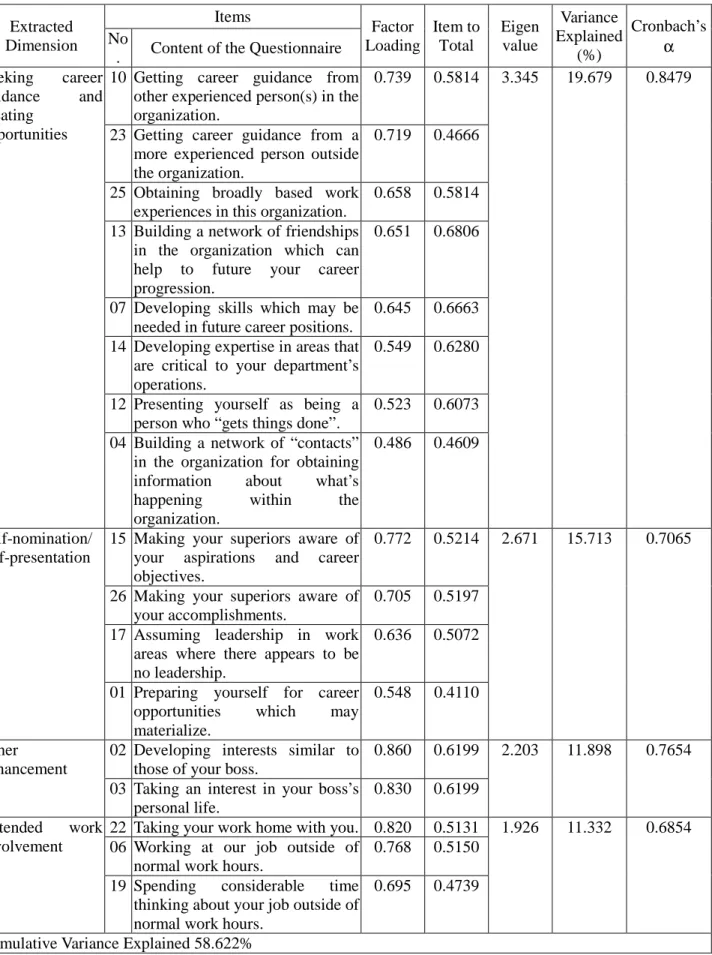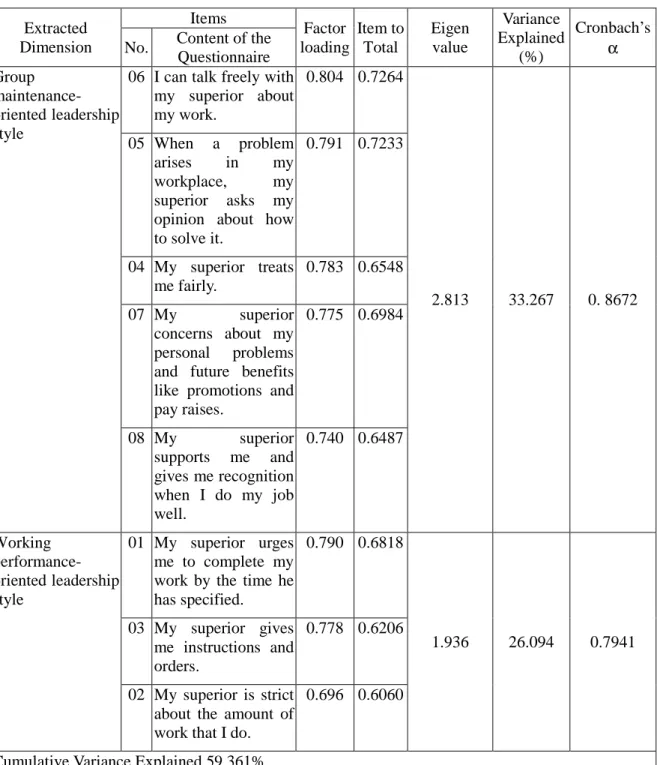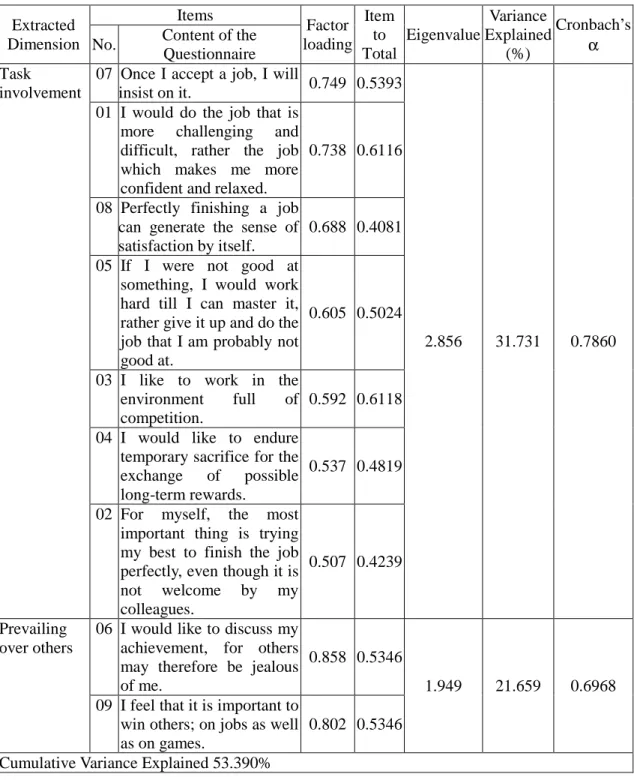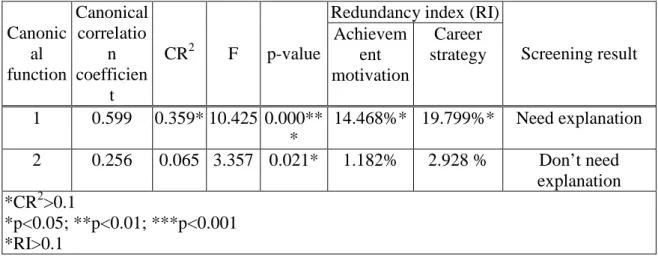Kuo, Y. -F. (2006), Influences on employee’s career strategy adoption of information service industry: Superior’s leadership styles or employee’s achievement motivation? International Journal of Management, 23(1), pp. 176-186.
Influences on Employee’s Career Strategy Adoption of Information Service Industry: Superior’s Leadership Styles or Employee’s Achievement Motivation?
The purpose of this study is to investigate the relationships between superior’s leadership styles and subordinate’s achievement motivation on subordinate’s career strategy adoption of information service industry in Taiwan. Canonical correlation analysis and t-test were used to analyze the data. Results indicate that superior’s leadership style has nothing to do with subordinate’s career strategy adoption, but subordinate’s achievement motivation has significant effect on their career strategy adoption. Additional, high achievement motivation employees adopt the career strategies more frequently than low achievement motivation employees do.
1. Introduction
Along with the rapid progress of information technology (IT), increasing dependence on IT for each industry and more and more complicated information application, the ratio of information service gets higher and higher. Information service industry is designed for providing information service, including software package, turnkey system, system integration, professional service, data processing and network service. The demand for manpower and the maintenance for elites will become one of the main issues for the information service industry. Currently, the insufficiency for manpower in the information industry forces the suppliers to recruit talents from other corporations with attractive offers. The high turnover of the employees will cause great loss to the enterprise. To keep the employees’ permanent and stable growth with the company and their devotion to the corporation and bring out their values to the enterprise, the enterprise should make the employees’ career advances with the development of the organization. For this reason, the enterprise must understand the employees’ career strategies they adopt and their influences, as well as help them achieve their career goals and enhance their work performance, which in turn push the performance of the whole enterprise forward to the goal of permanent management and growth. The influences on the career strategies are numerous; basically, they can be categorized as environmental factor, personal characteristics and experience, and need and values [22, 24]. Leadership is the ability that affects members to reach the target [21], so we take the leadership styles of superiors to represent the environmental factor in this study. Among numerous personal characteristics,
achievement motivation usually concerns with individual job performance and job attitude [20, 21], and McClelland's Trichotomy of Needs Theory [15] also considers achievement motivation as one of the three major needs affecting people’s work, so this study adopts the achievement motivation to reflect individual characteristics and needs. The relationship between the above two variables and career strategies will be studied thoroughly, hoping to explore the relationships between superior’s leadership style and subordinate’s achievement motivation on subordinate’s career strategy adoption of information service industry.
2. Literature Review and Research Hypotheses
Career strategy is a person’s method or behavior of to achieve the target of career in an organization [4]. The application of career strategies can accelerate a person’s speed of promotion in an organization and the raise of payment level [2, 3, 4, 6]. Thompson, et al. [27] are the first people who propose career strategy. They define career strategy according to members’ job change during working experience, which can be divided into four types: stable, professional, organizational, and free type. Gould and Penley [4] propose seven strategies such as creating opportunities, extended work involvement, self-nomination/self-presentation, seeking career guidance, networking, opinion conformity, and other enhancement that benefit for individual career progress. Besides, according to Gould and Penley’s scale [4], Yu [29, 30] performs empirical studies on Taiwan petrochemical industry, and Guthrie, et al. [5] investigate the relationships between personality and career strategies of US accountants. The scale items of career strategy proposed by Gould and Penley [4] are clearer, more specific, operational, and almost include other types of strategies, so they are chosen as the contents of career strategies in this study.
Leadership is the ability that affects members toward the achievement of goals [21]. Misumi [16] constructed PM (performance-maintenance) scale that measure leadership behavior, which divides leader behavior into two dimensions as working performance-oriented and group maintenance-oriented. Working performance-oriented indicates that the leader assign mission and severely control
and validity. In this study, PM leadership style scale [16] was used.
Achievement motivation is a very influential factor on employee of work motivation [20] and it is the power that drives a person to pursue success and an idea that makes a person want to overcome obstruction, complete difficult mission and surpass other people [1]. Steers and Porter [25] report that the workers who have high achievement motivation perform better on work than those who have low achievement motivation. From the perspective of objectives, Jagacinski and Nicholls [8, 9] indicate that achievement motivation is the action and behavior when a person expected to achieve a goal and people’s action and behavior varied from the environment and personality. Helmreich and Spence [7] indicate that personal achievement motivation consists of mastery, work-orientation, competition, and personal unconcern. In the study of employee’s achievement motivation and career strategies, Yu [29] takes the labor of petrochemical industry as the objects, and the results show, the adopting degree of the ones with high achievement motivation in creating opportunities, extended work involvement, self-nomination is significantly higher than the ones with low achievement motivation.
According to research purposes and related literatures, the hypotheses of this research are as follows:
H1: Superior’s leadership style has significant effect on subordinate’s career strategy adoption.
H2: Subordinate’s achievement motivation has significant effect on their career strategy adoption.
H2-1: There is significant difference on the adoption of the career strategy between high achievement motivation and low achievement motivation subordinates.
4. Research Methodology
The study was conducted in a survey. The questionnaire contained four parts. The first part dealt with respondents’ career strategies. As stated previously, career strategy inventory (CSI) [4], which totals 26 questions, was used to assess career strategies. The second part dealt with superior’s leadership style. This study modifies PM Inventory [16] measuring leading behavior. There are totally 8 questions with 3 related to performance-oriented dimension and 5 related to group maintenance-oriented dimension. The third part is the questions of achievement motivation. This study refers Helmreich and Spence’s [7] questionnaire to modify it as 9 questions. A five-point Likert scale ranging from 1 (very disagreed) to 5 (very agreed) was adapted to the above three inventory. The fourth part is the basic data which are primarily to understand the demographic structure of samples. In an attempt
to confirm the appropriateness of the questionnaire content, before the questionnaire investigation was executed, a pilot test was given to 15 EMBA students. This study investigated on the employees working in 100 companies that was randomly selected from 733 companies as identified in 3 Taiwan professional information service groups. A total of 400 questionnaires were distributed and 149 usable questionnaires were used in the analysis, representing a valid response rate is 37.25%.
5. Research Results 5.1 Analysis of Validity and Reliability
Tables 1 to 3 show the results of validity and reliability tests. Construct validity was tested using item-to-total correlation and factor analysis on three instruments. For convergent validity, items having item-to-total correlation scores lower than 0.4 were dropped from further analysis. The item-to-total correlations of all instruments are all positive and significant at the 0.001 levels. This study uses factor analysis to extract the dimensions of subordinate’s career strategy, achievement motivation, and superior’s leadership style, and for the basis of successive analysis. Factor analysis is also used to check discriminant validity [12]. For factor analysis, the principal component analysis with varimax rotation and eigenvalue greater than 1 and factor loadings greater than 0.4 was used [11]. Four dimensions were extracted for career strategies. They are career guidance and creating opportunities, self-nomination/self-presentation, other enhancement, and extended work involvement. Two dimensions were generated for leadership styles. They are group maintenance-oriented and working performance- oriented leadership styles. Two dimensions were generated for achievement motivation. They are task involvement and prevailing over others. The Cronbach’s α values for each dimension of career strategies ranged from 0.6854 to 0.8479. For leadership styles, the α values ranged from 0.7941 to 0.8672. For achievement motivation, the α values varied from 0.6968 to 0.7860. It shows that all scales are considerable reliability [19].
Table 1. Statistics for validity and reliability tests – career strategy Extracted Dimension Items Factor Loading Item to Total Eigen value Variance Explained (%) Cronbach’s α No
. Content of the Questionnaire Seeking career
guidance and
creating opportunities
10 Getting career guidance from other experienced person(s) in the organization.
0.739 0.5814 3.345 19.679 0.8479
23 Getting career guidance from a more experienced person outside the organization.
0.719 0.4666
25 Obtaining broadly based work experiences in this organization.
0.658 0.5814 13 Building a network of friendships
in the organization which can help to future your career progression.
0.651 0.6806
07 Developing skills which may be needed in future career positions.
0.645 0.6663 14 Developing expertise in areas that
are critical to your department’s operations.
0.549 0.6280
12 Presenting yourself as being a person who “gets things done”.
0.523 0.6073 04 Building a network of “contacts”
in the organization for obtaining information about what’s
happening within the
organization.
0.486 0.4609
Self-nomination/ self-presentation
15 Making your superiors aware of your aspirations and career objectives.
0.772 0.5214 2.671 15.713 0.7065
26 Making your superiors aware of your accomplishments.
0.705 0.5197 17 Assuming leadership in work
areas where there appears to be no leadership.
0.636 0.5072
01 Preparing yourself for career opportunities which may materialize.
0.548 0.4110
Other enhancement
02 Developing interests similar to those of your boss.
0.860 0.6199 2.203 11.898 0.7654 03 Taking an interest in your boss’s
personal life.
0.830 0.6199 Extended work
involvement
22 Taking your work home with you. 0.820 0.5131 1.926 11.332 0.6854 06 Working at our job outside of
normal work hours.
0.768 0.5150 19 Spending considerable time
thinking about your job outside of normal work hours.
0.695 0.4739
Table 2 Statistics for validity and reliability tests - leadership styles Extracted Dimension Items Factor loading Item to Total Eigen value Variance Explained (%) Cronbach’s α No. Content of the
Questionnaire Group
maintenance- oriented leadership style
06 I can talk freely with my superior about my work. 0.804 0.7264 2.813 33.267 0. 8672 05 When a problem arises in my workplace, my superior asks my opinion about how to solve it. 0.791 0.7233 04 My superior treats me fairly. 0.783 0.6548 07 My superior concerns about my personal problems and future benefits like promotions and pay raises. 0.775 0.6984 08 My superior supports me and gives me recognition when I do my job well. 0.740 0.6487 Working performance- oriented leadership style 01 My superior urges me to complete my work by the time he has specified. 0.790 0.6818 1.936 26.094 0.7941 03 My superior gives me instructions and orders. 0.778 0.6206 02 My superior is strict about the amount of work that I do.
0.696 0.6060
Table 3. Statistics for validity and reliability tests – achievement motivation Extracted Dimension Items Factor loading Item to Total Eigenvalue Variance Explained (%) Cronbach’s α No. Content of the
Questionnaire Task
involvement
07 Once I accept a job, I will
insist on it. 0.749 0.5393
2.856 31.731 0.7860
01 I would do the job that is more challenging and difficult, rather the job which makes me more confident and relaxed.
0.738 0.6116
08 Perfectly finishing a job can generate the sense of satisfaction by itself.
0.688 0.4081 05 If I were not good at
something, I would work hard till I can master it, rather give it up and do the job that I am probably not good at.
0.605 0.5024
03 I like to work in the environment full of competition.
0.592 0.6118 04 I would like to endure
temporary sacrifice for the exchange of possible long-term rewards.
0.537 0.4819 02 For myself, the most
important thing is trying my best to finish the job perfectly, even though it is not welcome by my colleagues.
0.507 0.4239
Prevailing over others
06 I would like to discuss my achievement, for others may therefore be jealous of me.
0.858 0.5346
1.949 21.659 0.6968
09 I feel that it is important to win others; on jobs as well as on games.
0.802 0.5346 Cumulative Variance Explained 53.390%
5.2 The Relationships between Superior’s Leadership Style and Subordinate’s Achievement Motivation on Subordinate’s Career Strategy Adoption
We take each dimension in leadership styles and achievement motivation as independent variables, and each dimension in career strategies as dependent variables, so as to understand the relationship between superior’s leadership style, subordinate’s achievement motivation on subordinates’ career strategy adoption. The canonical correlation analysis is used to get the linear combination with the maximum simple correlation between two groups of variables.
In the canonical correlation analysis of superior’s leadership style and subordinate’s career strategy, two groups of canonical functions are obtained (Table 4). Not every group of canonical functions deserves explanation after they are generated. They should be further screened to decide how many groups of canonical functions should be used. According to Thorndike [28], the screening criterion is: CR2 (canonical correlation coefficient square) value should be larger than 0.1, F-value should be significant level and Redundancy Index (RI) should be larger than 0.1. The canonical functions, which qualify all the three assessing criterions, are worth further explanation. According to Table 4, there is no any group of canonical functions of leadership style and career strategy complying with the above screening criterion. That is, there is no any linear combination relationship between leadership style and career strategy. Hence, H1 is not supported.
Table 4. Canonical correlation analysis results of leadership style and career strategy
Canonic al function Canonica l correlatio n coefficie nt CR2 F p-value Redundancy index (RI) Screening result Leadershi p style Career strategy 1 0.389 0.152* 3.897 0.000*** 4.968% 13.145% * Don’t need explanation 2 0.204 0.042 2.089 0.104 0.000% 0.000% Don’t need explanation *CR2>0.1 *p<0.05; **p<0.01; ***p<0.001 *RI>0.1
In the canonical analysis of subordinate’s achievement motivation and career strategy, two groups of canonical functions are obtained (Table 5). According to Thorndike [28], only the first canonical function should be explained. Lambert and Durand [13] point out that if the absolute value of canonical loading of the independent variables is larger than 0.3, it means the independent variable has strong predicting capability.
Table 5. Canonical correlation analysis results of subordinate’s achievement motivation and career strategy
Canonic al function Canonical correlatio n coefficien t CR2 F p-value
Redundancy index (RI)
Screening result Achievem ent motivation Career strategy 1 0.599 0.359* 10.425 0.000** * 14.468%* 19.799%* Need explanation 2 0.256 0.065 3.357 0.021* 1.182% 2.928 % Don’t need explanation *CR2>0.1 *p<0.05; **p<0.01; ***p<0.001 *RI>0.1
Table 6. Canonical loading and SMC of subordinate’s achievement motivation and career strategy
Canonical variable Canonical
loading SMC(%)
Achievement motivation
Task involvement 1.000* 100.00
Prevailing over others 0.324* 10.50
Career strategy
Seeking career guidance and creating opportunities
0.875* 76.75 Self-nomination/self-presentation 0.902* 81.36
Other enhancement 0.334* 11.16
Extended work involvement 0.382* 14.59
* |canonical loading |> 0.3
According to the first group of canonical functions in Table 5, the inter-explaining capability (canonical correlation coefficient) between the two variables, achievement motivation and career strategy, is 0.599. In the canonical loadings of the predictor variables (Table 6), the absolute values of “task involvement” (1.000) and “prevailing over others” (0.324) are greater than 0.3. In the canonical loadings of the criterion variables, the absolute values of “self-nomination/self-presentation” (0.902), “seeking career guidance and creating opportunities” (0.875), “extended work involvement” (0.382) and “other enhancement” (0.334) are greater than 0.3. This indicates that subordinates who do value “task involvement” and “prevailing over others” tend to adopt the strategies of “self-nomination/self-presentation”, “seeking career guidance and creating opportunities”, “extended work involvement” and “other enhancement” more. SMC (Square Multiple Correlation) in Table 6 means the capability for dependent variables or independent variables to explain the related variation of independent functions or dependent functions. The SMC of task involvement and prevailing over others are 100.00%, and 10.50%, respectively.
The results mentioned above indicate that there is a significant positive relationship between subordinate’s achievement motivation and his/her career strategy adoption. Furthermore, this study, according to the examinees’ scores on the motivation, divided them into high achievement motivation and low achievement motivation against the average score (3.5973), which in turn to examine the differentiation on the adoption of the career strategy of the high achievement motivation employees and low-level achievement motivation employees. To verify H2-1, this study used t test. Table 7 shows that high achievement motivation employees adopt the career strategies more than low achievement motivation employees. Accordingly, H2-1 is supported.
Table 7. Results of t test of subordinate’s achievement motivation and career strategy
Career strategy dimensions
Achievement motivation t p-value High (n=66) Low (n=83)
Career guidance & creating opportunities 4.3049 4.0196 4.403 0.000*** Self-nomination/self-presentation 4.1742 3.8012 4.879 0.000***
Other enhancement 3.0076 2.7470 2.213 0.028*
Extended work involvement 3.3081 3.0281 2.366 0.019* *p<0.05; **p<0.01; ***p<0.001
6. Discussions and Conclusions
This study has explored the effects between superior’s leadership style and subordinate’s achievement motivation on subordinate’s career strategies of information service industry. The results show that superior’s leadership style has no significant effect on subordinate’s career strategy adoption, but subordinate’s achievement motivation has significant effect on their career strategy adoption. Why is formal leader’s influence unnecessary for subordinates’ career strategy adoptions? In information service industry, the characteristics of employees with high educational
motivation with task involvement to increase the proper career strategy adoption then achieve their career goals is a big question that superiors should think about it. The enterprise may start from the job re-designing by “combining the job content with personal specialty and interests” and “increasing job variety, importance and integrity” to promote the subordinates’ sense of achievement. Additional, high achievement motivation employees adopt the career strategies more frequently than low achievement motivation employees do. High achievement motivation employees with stronger learning motive and striving for the best usually attribute their success to personal efforts and ability. They would keep improving their knowledge and skills; therefore, they tend to act with plans and targets. On the contrary, low achievement motivation employees care little about the success of their career; therefore, they hold a passive attitude toward the adoption of the career strategy.
Due to the limitation on the research purpose, this study could not take all influences on the career strategy into consideration, and could only take the information service industry in Taiwan as the research objective. Future researches may investigate on other influences, such as personal background, the interior and exterior factors of the enterprise and even make an investigation and comparison on different industry. Further, the stability of career strategy adoptions over time and whether career strategy adoptions are associated with different career development stages should also be examined.
Acknowledgement
This research is supported by National Science Council (NSC 91-2416-H-366-002) in Taiwan.
References
[1] Arkoff, A. (1968), Adjustment and Mental Health, New York, NY: McGraw-Hill. [2] Beehr, T. A., Taber, T. D. and Walsh J.T. (1980), Perceived mobility channels:
Criteria for intraorganizational job mobility, Organizational Behavior and Human Performance 26 250-264.
[3] Gould, S. (1979), Characteristics of career planners in upwardly mobile occupations, Academy of Management Journal 22 539-550.
[4] Gould, S. and Penley, L. E. (1984), Career strategies and salary progression: A study of their relationships in a municipal bureaucracy, Organizational Behavior and Human Performance 34 244-265.
[5] Guthrie, J. P., Coate, C. J and Schwoerer, C. E. (1998), Career management strategies: The role of personality, Journal of Managerial Psychology 13 (5/6) 371-386.
[6] Hall, D. T. (1976), Careers in Organizations, Pacific Palisades, CA: Goodyear. [7] Helmreich, R. L. and Spence, J. T. (1978), The work and family orientation
questionnaire: An objective instrument to assess components of achievement motivation and attitudes toward family and career, JSAS Catalog of Selected Documents in Psychology 8(35) 21-35.
[8] Jagacinski, C. M. and Nicholls, J. G. (1984), Conceptions of ability and related affects in task involvement and ego involvement, Journal of Educational Psychology 76 909-919.
[9] Jagacinski, C. M. and Nicholls, J. G. (1987), Attributional focus of praise and children’s intrinsic motivation: The moderating role of gender, Journal of Educational Psychology 79 107-114.
[10] Kahn, R. and Katz, D. (1960), Leadership practices in relation to productivity and morale, In Cartwright D. and Zander A. (ed.), Group Dynamics: Research and Theory, New York, NY: Harper and Row.
[11] Kaiser, H. F. (1958), The varimax criterion for analytic rotation in factor analysis, Psychometrika 23(3) 187-200.
[12] Kerlinger, F. N. (1986), Foundation of Behavioral Research, 3rd ed., Fort Worth, TX: Holt, Rinehart and Winston.
[13] Lambert, Z. A. and Durand, R. M. (1975), Some precautions in using canonical analysis, Journal of Marketing Research 12(4) 468-475.
[14] Lee, Y. D. (1999), A research on style, communication satisfaction and leadership effectiveness in the food industry – A comparative analysis between Taiwan and Mainland China, Chang Jung Journal 3(1) 49-64.
[15] McClelland, D. C. (1985), Human Motivation, Glenview, IL: Scott, Foresman and Company.
[16] Misumi, J. (1985), The Behavioral Sciences of Leadership: An Interdisciplinary Japanese Research Program, Ann Arbor, MI: University of Michigan Press.
[17] Misumi, J. (1995), The development in Japan of the performance-maintenance (PM) theory of leadership, Journal of Social Issues 51(1) 213-228.
[18] Misumi, J. and Peterson, M. F. (1985), The performance-maintenance (PM) theory of leadership: Review of a Japanese research program, Administrative Science Quarterly 30 198-223.
[19] Nunnally, J. C. (1978), Psychometric Theory, New York, NY: McGraw-Hill. [20] Poulin, J.E. (1994), Job task and organizational predicators of social worker
career strategy change: A panel study, Administration in Social Work 18(1) 21-39. [21] Robbins, S. P. (2001), Organizational Behavior, Upper Saddle River, NJ:
Prentice Hall.
[22] Roe, A. (1957), Early determinants of vocation choice, Journal of Counseling Psychology 4 212-217.
[23] Smith, P. B., Misumi, J., Tayeb, M., Peterson, M. and Bond, M. (1989), On the generality of leadership style measures across cultures, Journal of Occupational Psychology 62(2) 97-109.
[24] Souerwine, A. H. (1978), Career Strategies: Planning for Personal Achievement, New York, NY: AMACOM.
ROC, Part C: Humanities and Social Sciences 4(2) 286-304.
[30] Yu, C. C. (1995), Comparative study on career strategies of employees in petrochemical industry, Journal of Labor Studies 3 1-27.





